Sustainable fashion has undergone a remarkable transformation, evolving from the hippie movement's embrace of upcycling and anti-consumerism to today's luxury brands prioritizing eco-friendly practices. In the 1960s, hippies favored natural fabrics and vintage styles, while the 1980s saw anti-fur campaigns. As fast fashion gained popularity in the 1990s, consumer awareness began shifting, highlighting the environmental toll of cheap, disposable clothing. Now, with a stronger focus on ethical craftsmanship and sustainable materials, you'll find that shoppers increasingly seek out quality over quantity. Stay with us, and you'll uncover more about this fashionable evolution and its impact on the industry.
Key Takeaways
- Sustainable fashion began in the 1960s, influenced by counterculture movements like the hippies, emphasizing natural materials and anti-consumerism.
- The slow fashion movement emerged in the 2000s, advocating for ethical production, quality garments, and environmental responsibility.
- Fast fashion's rise led to significant environmental issues, making consumer awareness and demand for sustainable practices increasingly important.
- Modern sustainable practices include eco-friendly materials, upcycling, and transparency, addressing challenges such as production costs and consumer skepticism.
- The eco-luxury market is projected to grow significantly, with consumers increasingly willing to pay more for sustainable and ethically produced fashion.
Historical Roots of Sustainable Fashion

Tracing its origins back to the 1960s, sustainable fashion emerged as a response to consumerism, driven by counter-culture movements like the hippies who championed natural fabrics and simpler lifestyles.
The sustainable fashion movement began with a rejection of mass-produced clothing, emphasizing ethical fashion and environmentally friendly materials. As you dive deeper, you'll notice how the punk movement in the 1970s further shaped this ideology by promoting upcycling and secondhand shopping, challenging traditional fashion norms.
In the 1980s, influential figures like Katharine Hamnett raised awareness about the socio-ecological impact of fashion, particularly through campaigns against fur.
Fast fashion, a term coined in the 1990s, highlighted the rapid production cycles of brands like Zara, coinciding with growing concerns over climate change and the ecological toll of mass production. This paved the way for the slow fashion movement in the 2000s, which advocated for ethical labor practices and environmental responsibility.
As you see, the roots of sustainable fashion are deeply intertwined with social and environmental movements, creating a rich history that informs today's fashion choices.
Emergence of Counterculture Influences
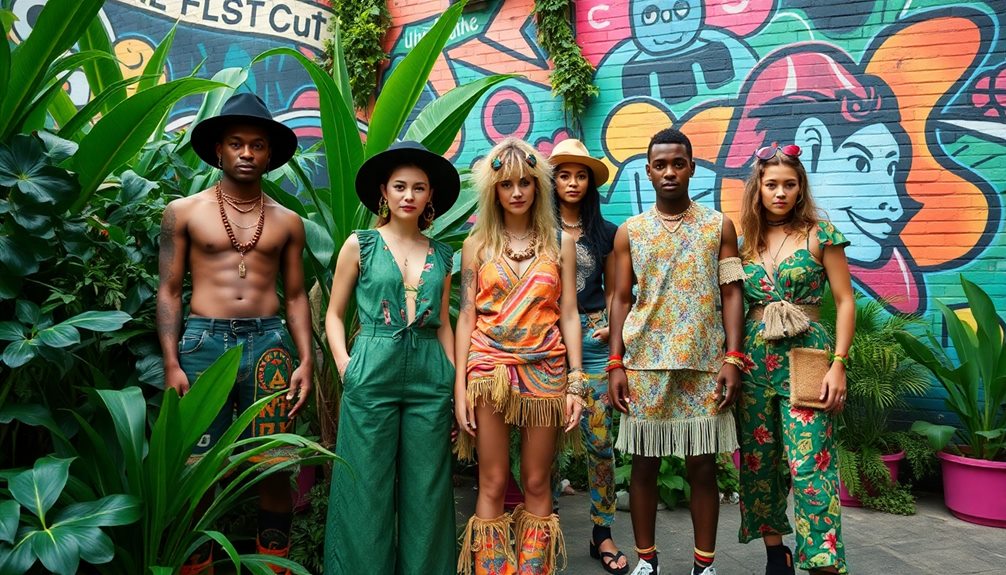
The hippie movement of the 1960s laid the foundation for sustainable fashion by promoting natural fabrics and a lifestyle free from consumerism.
Then in the 1970s, punk fashion took it a step further, using upcycled and secondhand clothing as a bold statement against mainstream trends.
These counterculture influences not only shaped personal style but also sparked a broader conversation about ethical fashion choices.
Hippie Movement's Impact
Rebellion against conformity defined the hippie movement of the 1960s, shaping a new perspective on fashion that emphasized sustainability and individuality. By prioritizing natural materials and simplicity, you see how hippies rejected mass-produced clothing in favor of handmade and vintage styles. This laid the groundwork for future sustainable fashion practices.
Their appreciation for organic and natural fibers parallels the growing awareness of health effects of tea consumption, as both movements promote a return to more holistic and environmentally friendly choices.
Embracing upcycling and thrifting, the hippie movement promoted a lifestyle centered on sustainability and the reuse of materials. This not only influenced alternative fashion narratives but also sparked early discussions on the environmental impact and ethical implications of fashion.
You can trace a direct line from their resistance to synthetic materials to the eco-conscious movements that followed.
Furthermore, iconic figures like musicians and artists popularized this more sustainable and ethical lifestyle, encouraging you and others to contemplate the social and environmental costs of your clothing choices.
The hippie movement set a precedent, reminding everyone that fashion could be a powerful tool for change, advocating for a more mindful approach to consumption.
As you reflect on today's sustainable fashion landscape, the influence of the hippie movement becomes increasingly clear and relevant.
Punk Fashion Rebellion
Punk fashion's defiance of societal norms ignited a movement that celebrated individuality and creativity through DIY aesthetics. Emerging in the 1970s, punk rock embraced upcycling and thrifting, pushing back against mainstream consumerism.
You'd see punks sporting DIY clothing modifications, each piece a unique statement reflecting their resistance to conformity. This ethos mirrors the growing demand for sustainable practices in various industries, including the rise of renewable energy solutions that promote eco-friendliness and efficiency.
Icons like Vivienne Westwood and Malcolm McLaren used recycled materials and secondhand items to craft bold fashions that tackled social issues head-on. By incorporating shock value—think torn fabrics, safety pins, and edgy graphics—they conveyed powerful messages against societal expectations and wastefulness in consumption.
This anti-establishment ethos not only reshaped fashion but also heightened awareness of the industry's environmental impact, laying groundwork for future sustainable practices.
Punk fashion's focus on sustainability and ethical considerations can be viewed as a precursor to today's eco-conscious movements.
Ultimately, the punk fashion rebellion didn't just challenge conventional styles; it sparked a dialogue about sustainability and the importance of mindful consumption.
Rise of Fast Fashion
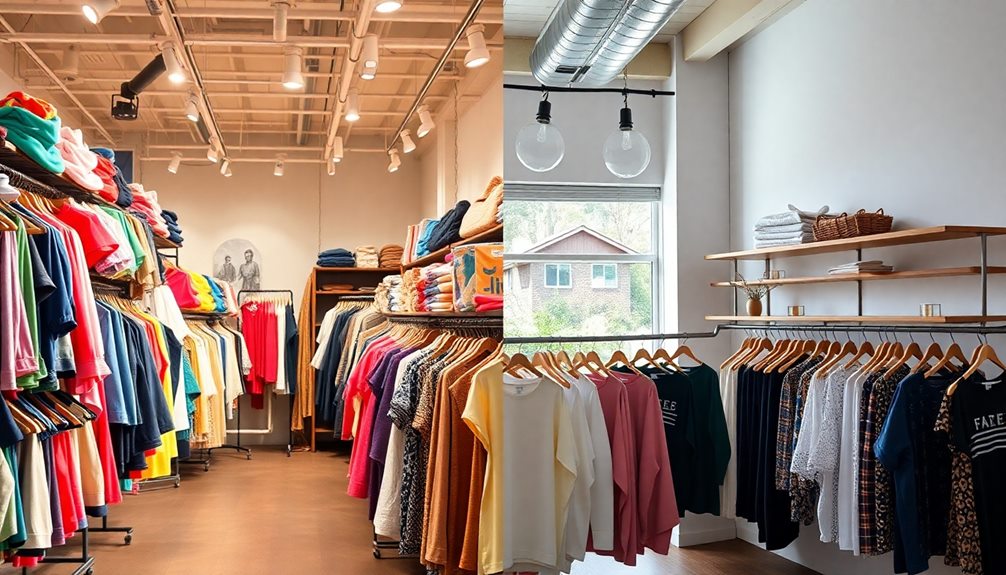
Fast fashion emerged in the 1990s, fueled by brands like Zara that prioritized quick production and low prices.
As consumers embraced this trend, awareness of its environmental impact began to grow, prompting shifts in buying behavior.
You might find yourself questioning whether the convenience of fast fashion is worth the cost to our planet.
Fast Fashion Emergence
In the 1990s, a seismic shift occurred in the fashion industry with the introduction of fast fashion, a term popularized by The New York Times to describe Zara's rapid production model. This change prioritized speed and low costs over quality, leading to a surge in global clothing consumption.
By the late 1990s, you saw fast fashion becoming a highly desirable option, characterized by cheap, disposable clothing.
Consider these key elements:
- Fast fashion contributed to a 400% increase in clothing consumption from 2000 to 2015.
- Consumers purchased two tonnes of clothing every minute in the UK.
- The industry is the second largest consumer of water globally.
- Synthetic materials accounted for 39% of clothing sales by the 1990s.
- Projections suggest non-biodegradable fabrics will reach 75% of clothing by 2030.
As a consumer, you might appreciate the affordability of fast fashion, but it's crucial to recognize its environmental impact.
The production process behind these trendy pieces often neglects sustainable practices, leading to waste and pollution problems that can no longer be ignored.
Environmental Impact Awareness
A growing awareness of the environmental impact of fast fashion is reshaping consumer attitudes and behaviors. You may not realize it, but fast fashion is responsible for 10% of global greenhouse gas emissions. This rapid production cycle, popularized by brands like Zara in the 1990s, considerably depletes resources, with conventional cotton farming requiring 2,500 liters of water per shirt.
As global clothing consumption skyrocketed to 80 billion pieces annually by 2015, the consequences became undeniable: excessive waste and pollution.
Moreover, a staggering 35% of ocean microplastics stem from synthetic textiles, primarily due to the laundry cycles of fast fashion garments. This alarming statistic highlights the urgent need for environmental awareness among consumers like you.
As we look toward the future, projections suggest that by 2030, non-biodegradable synthetic fabrics will make up 75% of clothing, exacerbating the issues tied to climate change.
With this knowledge, you're in a unique position to drive change. By prioritizing sustainable fashion choices, you contribute to a collective effort to reduce the fashion industry's environmental footprint, fostering a more responsible approach to style.
Consumer Behavior Shifts
Over the last few decades, many consumers have embraced fast fashion, drawn in by its affordability and trendy offerings. This shift in consumer behavior has led to a staggering increase in global clothing consumption, with many unaware of the environmental and social impact tied to their buying choices.
Fast fashion encourages a throwaway culture, where clothes are purchased and discarded without much thought. As more individuals seek to improve their emotional well-being, there's a growing recognition of the importance of mindful consumption, akin to the practices that help individuals connect with the Vortex.
Consider these factors shaping consumer habits:
- Fast fashion brands produce trendy items at low prices.
- The rapid turnover of styles keeps you constantly buying.
- Many consumers prioritize cost over sustainability and ethics.
- Awareness of climate change has started to influence some buying decisions.
- The environmental impact of clothing production often goes unnoticed.
As you reflect on your shopping habits, it's crucial to recognize the consequences. Fast fashion contributes to pollution, with synthetic fabrics polluting oceans and conventional cotton farming draining precious water resources.
The growing awareness of climate change is prompting a shift towards more sustainable and ethical practices. By making conscious choices when buying clothes, you can become part of the movement advocating for a more responsible fashion industry, ultimately shaping a healthier planet for future generations.
Transition to Ethical Awareness
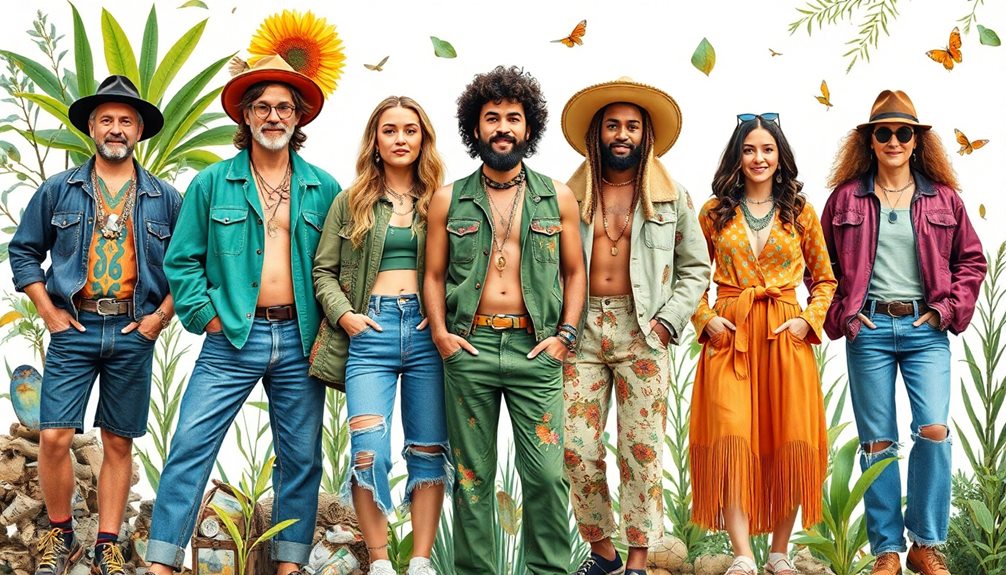
Many people may not realize that the journey toward ethical awareness in fashion has roots stretching back to the 1960s. The hippies rejected consumerism by embracing natural fabrics and sustainable practices, laying the groundwork for a conscious approach to style.
In the 1970s, punks further propelled this shift to ethical awareness by promoting thrifting and upcycling as alternatives to the mass-produced clothing that dominated the market.
The 1980s saw influential campaigns, such as the anti-fur movement led by figures like Katharine Hamnett, which raised awareness about animal rights and ethical fashion choices.
As the 1990s rolled in, the term "fast fashion" emerged, highlighting the rapid production model that consumers began to scrutinize. This scrutiny marked a significant shift in how brands were perceived regarding their sustainability and ethical practices.
A pivotal moment came in 2013 with the Rana Plaza factory collapse, which intensified global dialogue surrounding ethical fashion. This tragedy pushed consumers to demand greater transparency and social responsibility from brands.
Today, the shift to ethical awareness continues to evolve, encouraging you to make mindful choices in your fashion consumption.
Principles of Slow Fashion
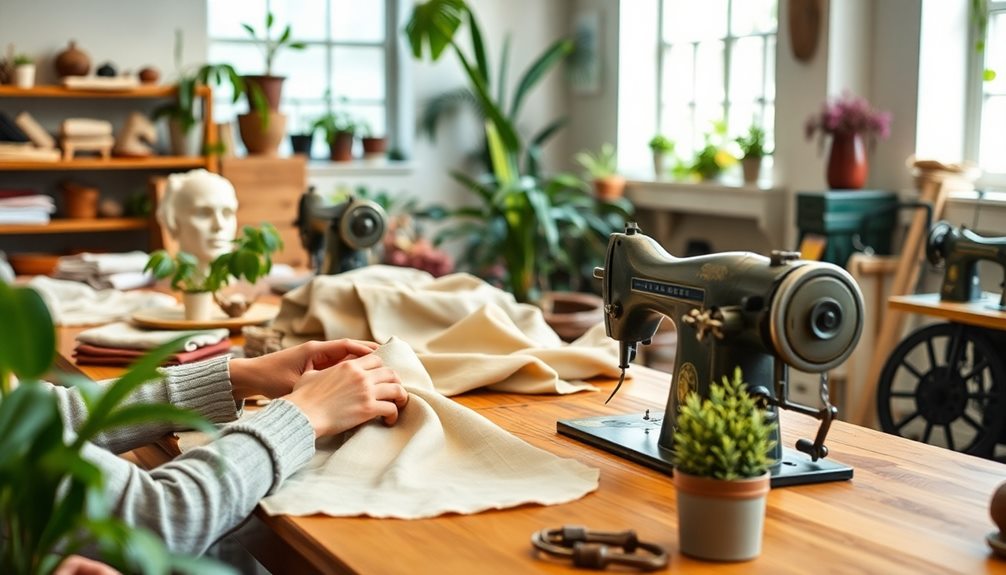
When you embrace slow fashion, you're choosing quality over quantity, ensuring your wardrobe is filled with well-made pieces that last.
This approach encourages you to practice mindful consumption, focusing on repairing, reusing, and recycling your clothing. This approach encourages you to practice mindful consumption, focusing on repairing, reusing, and recycling your clothing. By adopting this mindset, you not only extend the life of your wardrobe but also make more intentional choices about new items you bring in. For example, when seeking Alaskan cruise packing tips, consider versatile, high-quality pieces that can be layered and reused throughout your trip, reducing the need for excessive purchases. Taking small steps like these helps contribute to a more sustainable lifestyle.
Quality Over Quantity
Typically, slow fashion emphasizes quality over quantity, inviting you to rethink your approach to clothing.
This movement encourages you to invest in garments that last, crafted with care and made from sustainable materials.
When you choose slow fashion, you're not just buying clothes; you're supporting a philosophy that values:
- Quality manufacturing that guarantees longevity
- Sustainable materials like organic cotton and Eri silk
- Mindful consumption by buying less but better
- Repair and reuse to extend the life of your garments
- Eco-friendly practices that reduce environmental impact
Mindful Consumption Practices
Mindful consumption practices form the backbone of the slow fashion movement, urging you to think deeply about your clothing choices. Instead of succumbing to the allure of fast fashion, you're encouraged to invest in high-quality garments that last. This means prioritizing sustainable materials, like organic cotton and recycled fabrics, which greatly reduce environmental impact during production.
Transparency in the production process is crucial. As you become more aware of where and how your clothes are made, you'll likely gravitate towards brands that prioritize ethical labor and sustainable sourcing. This shift isn't just about the clothes you wear; it reflects a broader commitment to the planet and its people.
Repairing and reusing garments is another essential principle of slow fashion. By taking the time to mend your clothes or repurpose them, you extend their lifecycle and minimize waste in landfills.
With community initiatives and educational programs rising, you're not alone in this journey. The trend towards mindful consideration of fashion consumption has led to a remarkable decrease in monthly clothing purchases. Embracing these practices not only enhances your wardrobe but also contributes to a more sustainable future.
Ethical Labor Standards
Ethical labor standards are at the heart of the slow fashion movement, ensuring that the people behind your clothes work in fair and safe conditions. By prioritizing these principles, you support a more sustainable fashion industry that values both people and the planet.
Here's what you need to know:
- Fair wages: Workers receive appropriate compensation for their skills and labor.
- Safe working conditions: Brands commit to providing a safe environment free from hazards.
- Support for local artisans: Slow fashion promotes the use of craftspeople, preserving traditional skills.
- Transparency: Brands share information about their production processes, allowing you to make informed choices.
- Certification initiatives: Look for brands that verify ethical labor practices through recognized standards.
When you choose slow fashion, you're actively participating in a movement that champions ethical practices.
It's not just about buying clothes; it's about making a statement. By embracing sustainable fashion, you contribute to a cycle of fair trade and respect for craftsmanship.
Together, we can foster a fashion landscape where ethical labor standards rise to the forefront, benefiting everyone involved.
Environmental Impact of Fashion
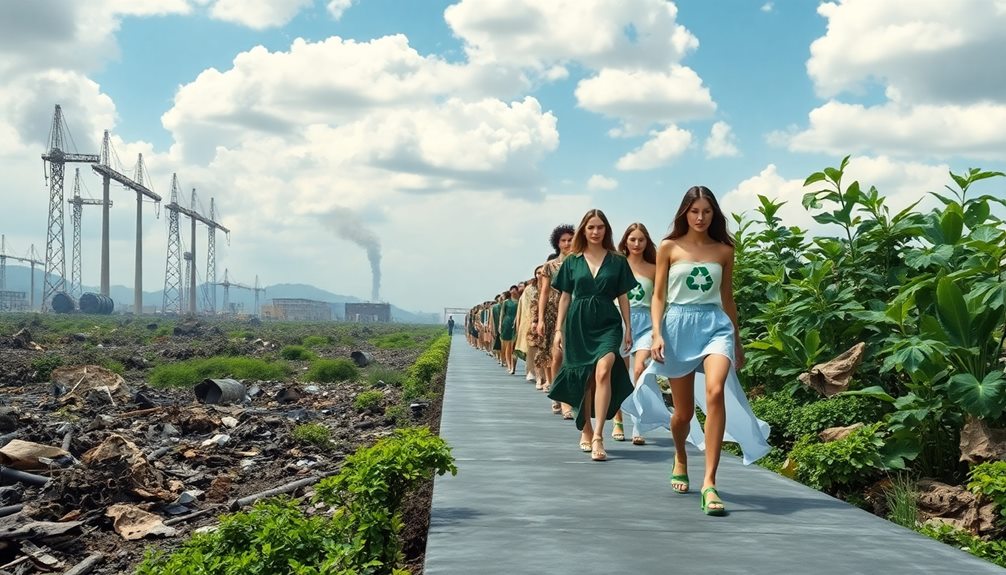
The fashion industry casts a long shadow on our environment, making it the second-largest global polluter. It contributes a staggering 10% of all greenhouse gas emissions, directly impacting climate change.
Fast fashion plays a significant role in this crisis, being responsible for 35% of ocean microplastics. Each time you wash synthetic textiles, tiny fibers are released, polluting our waters.
Additionally, conventional cotton farming strains our resources, requiring around 2,500 liters of water just to produce a single shirt, which intensifies water scarcity.
With global clothing consumption skyrocketing to 80 billion pieces annually by 2015, we've seen a 400% increase in the last two decades, leading to rampant overproduction and waste.
In the UK alone, consumers dispose of an average of 37 kg of clothing per person each year, highlighting the urgent need for sustainable practices in fashion.
You can help combat these issues by being mindful of your clothing choices. Opt for quality over cheap fashion, support brands that prioritize sustainability, and consider recycling or donating items instead of tossing them away.
Every small change can contribute to a healthier planet.
Consumer Behavior Shifts
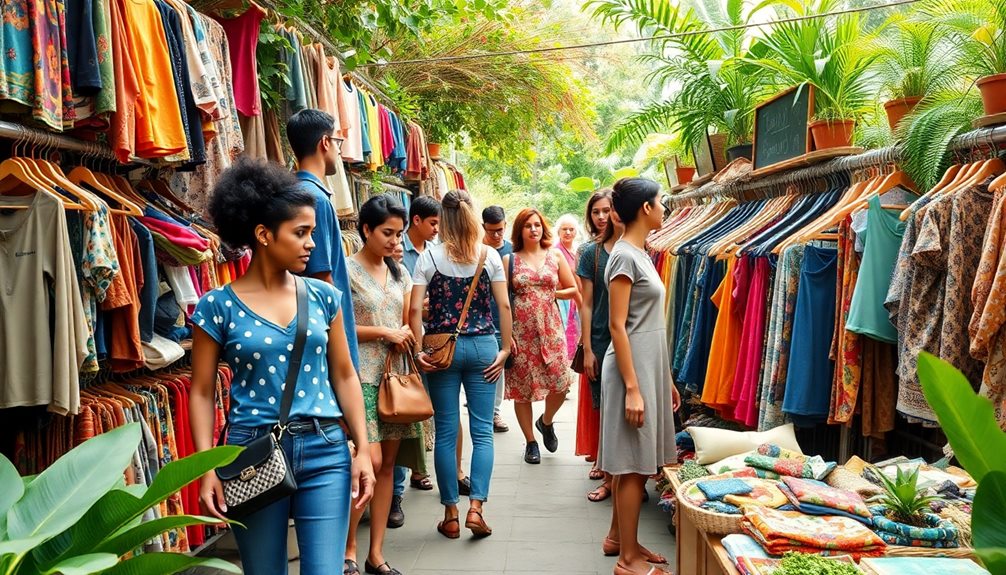
Sustainable fashion is no longer just a trend; it's becoming an essential part of consumers' everyday choices.
You're witnessing a significant shift in consumer behavior, where eco-consciousness influences what people buy. Over 60% of shoppers now prioritize sustainability in their purchasing decisions, and this change is reshaping the fashion landscape.
Consider these impactful shifts:
- 20% of UK consumers reported buying sustainable fashion products in 2020.
- 75% of Generation Z members prioritize sustainable practices over brand prestige.
- The second-hand and vintage market grew by 27% from 2020 to 2021, fueled by interest in pre-loved fashion.
- As of 2021, 42% of UK consumers found half of their wardrobes sourced from second-hand options.
- Ethical choices aren't just a preference; they're becoming a norm.
These trends reflect a collective move towards thrift and sustainability, with consumers actively seeking out eco-friendly brands and second-hand items.
As you embrace sustainable fashion, you're not only making a personal choice but also contributing to a larger movement that values the planet and ethical consumption.
Modern Sustainable Practices
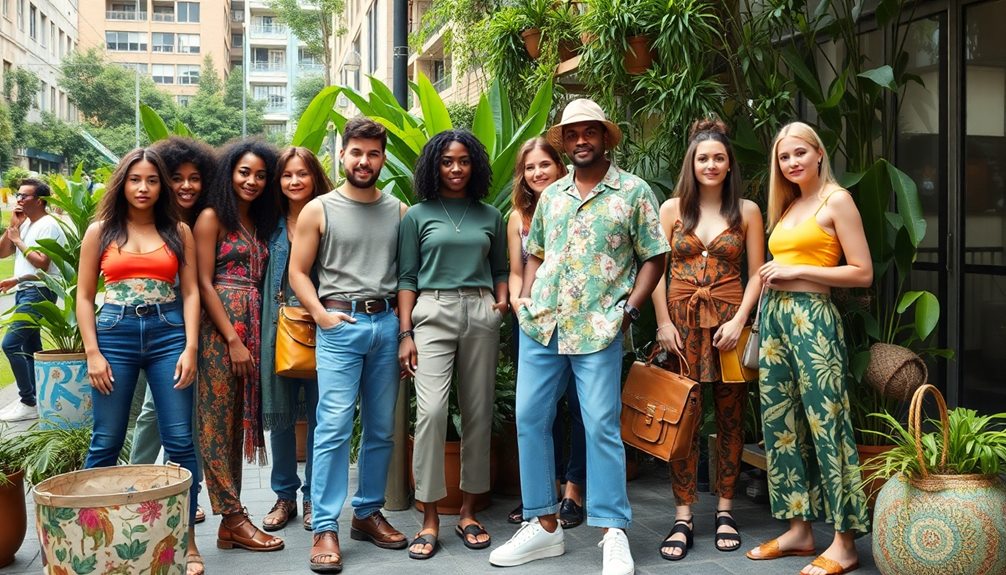
As consumers increasingly prioritize eco-conscious choices, modern sustainable practices in fashion are stepping into the spotlight. Fashion brands are shifting towards eco-friendly materials, prominently featuring organic cotton, recycled textiles, and biodegradable fabrics. This shift not only reduces environmental impact but also appeals to the growing demand for responsible production.
Upcycling is becoming a key technique where designers create new garments from existing materials, minimizing waste and breathing new life into old fabrics. Zero-waste fashion design is also gaining traction, allowing for innovative patterns that utilize every scrap of fabric.
The rise of digital platforms and social media has made sustainable fashion more accessible, empowering you to make informed choices about your purchases. You're likely noticing a significant growth in the second-hand fashion market, which is expected to grow over 27% from 2020 to 2021. This indicates a clear shift towards sustainable consumption patterns and a willingness to embrace pre-loved items.
Collaborations between designers and eco-friendly fabric producers are becoming more common, promoting innovative designs and responsible sourcing practices.
These modern sustainable practices not only redefine fashion but also contribute to a healthier planet.
Challenges Facing Sustainable Fashion
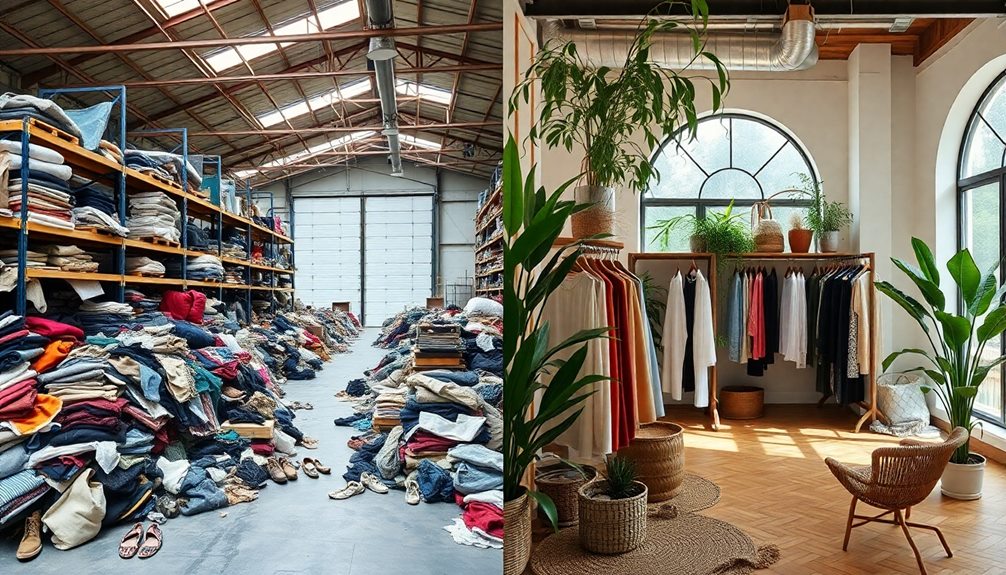
Steering through the landscape of sustainable fashion isn't without its hurdles. As you explore this vibrant movement, you'll quickly realize that several challenges can impede its growth and acceptance.
- Higher production costs compared to fast fashion can make it tough for brands to keep prices competitive.
- Limited availability of sustainable materials restricts production capacity, affecting scalability.
- Consumer skepticism around brand claims often leads to accusations of greenwashing, where brands misrepresent their sustainability efforts.
- The industry lacks standardized regulations to guarantee that ethical practices are genuinely implemented rather than just marketing gimmicks.
- Balancing affordability with sustainability is essential, as many shoppers still prioritize low-cost options over ethical considerations.
Navigating these challenges requires a collective effort from brands, consumers, and policymakers.
By fostering a deeper understanding of sustainable fashion and advocating for transparency, you can help combat greenwashing and support genuine ethical practices.
As you make more informed choices, you contribute to a marketplace that values sustainability over fast fashion, paving the way for a more responsible industry.
The road may be rocky, but every step you take pushes the movement forward.
Future of Eco-Luxury Fashion
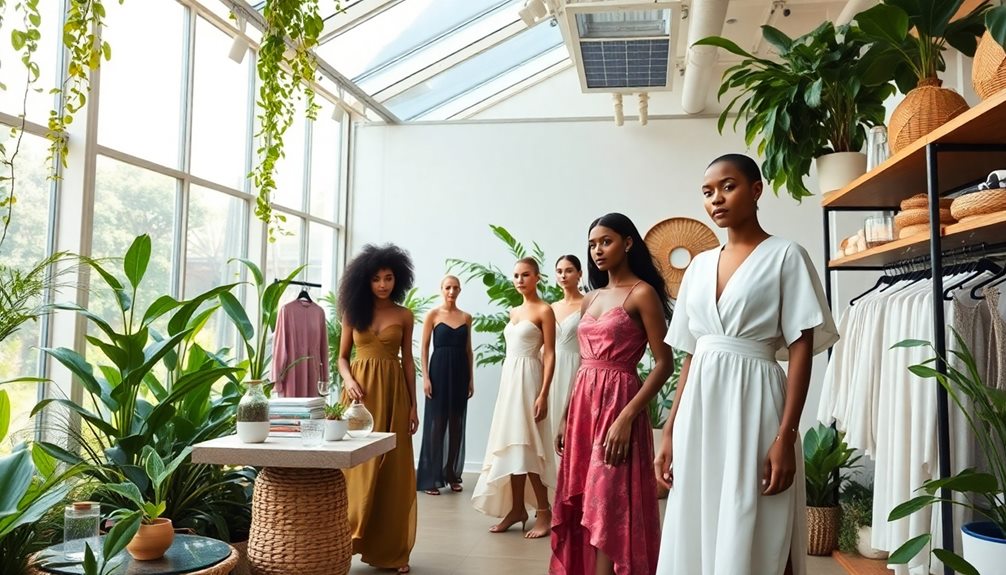
The challenges facing sustainable fashion have sparked a significant shift in the luxury sector, paving the way for eco-luxury fashion's bright future. As you look ahead, you'll notice that the eco-luxury market is projected to grow by over 10% in the next decade. This growth is fueled by increasing consumer demand for sustainably and ethically produced luxury goods. You might find it encouraging that 57% of consumers are willing to pay more for eco-friendly products, emphasizing a preference for quality and sustainability.
Luxury brands are adopting innovative materials, like biodegradable fabrics and recycled textiles, which promote a circular economy. Transparency has become essential, with 67% of millennials expecting brands to share their environmental and social practices. This focus on transparency boosts consumer trust and brand loyalty. Additionally, collaborations between luxury fashion houses and sustainability organizations are fostering innovation and raising awareness about eco-conscious choices.
| Trend | Impact on Eco-Luxury Fashion | Consumer Engagement |
|---|---|---|
| Biodegradable Fabrics | Reduces environmental impact | Increases trust |
| Transparency | Builds brand loyalty | Enhances customer connection |
| Circular Economy | Promotes resource efficiency | Encourages sustainable choices |
| Ethical Collaborations | Fosters innovation | Educates consumers |
| Increased Consumer Demand | Drives market growth | Influences brand practices |
Frequently Asked Questions
When Did the Sustainable Fashion Movement Start?
The sustainable fashion movement really started gaining momentum in the 1970s. You'll see its roots in counter-culture movements that challenged consumerism, pushing for more environmentally friendly and ethical practices in the fashion industry.
How Has Sustainable Fashion Changed Over Time?
Sustainable fashion's journey resembles a vibrant tapestry, weaving together ethics and style. Over time, you've witnessed a shift from counter-culture ideals to mainstream awareness, as brands embrace eco-friendly practices, transforming your shopping experience into a conscious choice.
What Is the Most Successful Campaign Currently in the Sustainable Fashion Movement?
You might find the "Fashion Revolution" campaign to be the most successful in sustainable fashion. It encourages you to ask brands, "Who made my clothes?" promoting transparency and empowering consumers to make informed choices about their purchases.
Are Hippies Against Fast Fashion?
You might recall the ethos of the 1960s; hippies indeed stand against fast fashion. They championed sustainable practices, embracing handmade craftsmanship and prioritizing quality over quantity, which aligns with their values of environmental conservation and authenticity.
Conclusion
Sustainable fashion isn't just a trend; it's a movement that's reshaping how we think about clothing. Did you know that the fashion industry accounts for about 10% of global carbon emissions? That's a staggering figure that highlights the urgency for change. By embracing the principles of slow fashion and supporting eco-luxury brands, you can be part of the solution. Together, we can turn the tide on environmental impact and foster a more sustainable future for fashion.









